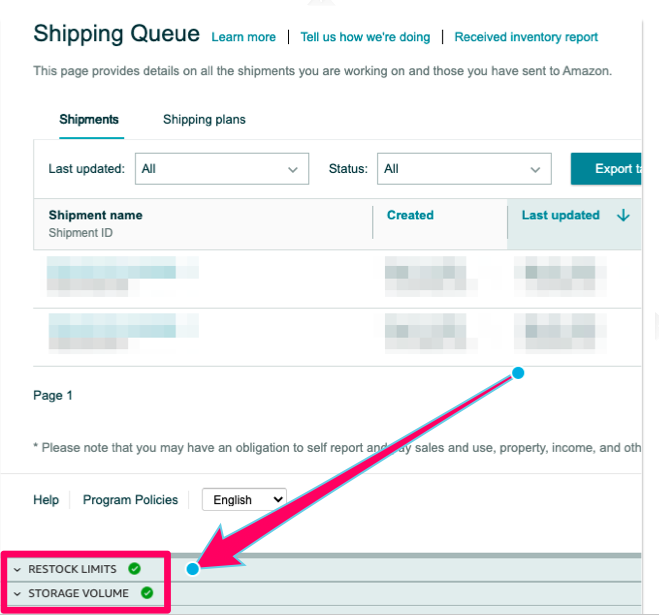-
Amazon Storage Limits
By ZonSupport | Posted on April 30, 2021| Blog
Amazon’s recent announcement regarding the change to how they will calculate storage limits is arguably two steps forward and two back.
Yes, it makes it so much easier to understand and to plan for. But, you really need to get into the detail to ensure you understand the implications, particularly around shipping plans.
Your restock limits are now at the account level, not the ASIN level, and they are by “storage type,†at the account level. This is a very significant change in direction by Amazon.
The different storage types have limitations listed eg standard size storage, oversize storage, apparel storage, and footwear storage.Â
As always there are two sides to every coin and this will impact sellers in different ways depending on their activity. I read a blog written by Helium 10 and found it the most informative I have seen on this topic. So, I reached out to them for the OK to summarize their blog on this simple but complex change.
Here’s the Amazon announcement:
“Effective April 22, 2021, FBA products will no longer be subject to ASIN-level quantity limits. Instead, restock limits will be set at the storage-type level, offering you more flexibility in managing your shipments.â€
How can you see what your limitations are?
First, go to your Shipping Queue in seller central.
Then scroll ALL the way down to the bottom and you’ll see tiny tabs that are very easy to miss:
Click on the Restock limits, and it will expand and show you your limitations.Â
It’s not all rainbows and unicorns though.
The Negative Implications of Amazon’s Changes
This inventory capacity also includes your inbound shipments. So, if you are stocking up ahead of a sales season for your product, you can quickly run out of “capacity.†This will stop you from creating a new shipment plan so for now we remain stuck with using a 3PL service.
Many sellers are already posting about this so maybe over time Amazon might change how this new limit is executed.
What are the current options for Amazon Sellers? Â Â
You will have to play the waiting game and use a 3PL as your local storage and trickle in your inventory as your limit allows.
The transit time will be a week in most cases (assuming Amazon can actually get them processed) as opposed to around 2 months from China, Vietnam, India, etc.
Shipping products to a 3PL is just like shipping them to Amazon. However, any warehouse will charge you money to receive and store this inventory so you need to ensure you take account of these costs ahead of time.
A Closer Look at Amazon’s Changes
Amazon has a very detailed FAQ page about the ins and outs of this new standard. Let’s go over a few of the questions to see what we can learn.Â
First of all, Amazon offers a big highlighted text warning to the sellers out there who, like during the Covid limitations last year, might want to try to skirt the system by using browser tricks or other hacks to get extra inventory.
How are restock limits by storage type determined?
Amazon explains that the limitations are based on past and forecasted sales. So, in many cases, you should be ok if you have had steady sales, and do not have too much stock on hand and on the way.Â
How do you calculate utilization?
As mentioned earlier, your utilization doesn’t just consist of your on-hand inventory.
As with the previous ASIN level inventory limitations, all of your incoming shipments, including shipments in working, transit, or receiving status are also included.
What is NOT included in your utilization are inventory pending removals as well as reserved inventory. Â
Will my FBA restock limits change?
Amazon says that they “will update restock limits regularly.†How regularly, we are not sure. It seemed like for the ASIN level restrictions, they would update it daily.Â
How can I reduce my utilization to create additional shipments?
There are various ways to do this. Selling more product, pulling inventory OUT of Amazon to your local warehouse, or canceling open shipments that you have that you do not plan to use.Â
How do my Multi-Channel Fulfillment (MCF) orders affect my restock limits?
There is a positive here. If you sell on Shopify or other websites and use MCF to fulfill those orders, you will be happy to know that these shipments are included in your past and forecasted sales, and absolutely will have an impact on your restock limits.Â
In summary, it is even more critical that you create a realistic sales forecast and plan your inventory requirements in detail.
If you are near their limit and your sales velocity and lead time are going to take you to the wire then stop. Longer shipping times are our new reality so don’t cut yourself short to avoid using a 3PL and end up running out of stock!Â
If you are well under the limit with your current product range, then launching a new product just became easier as you are no longer limited to 200 units.Â
Regardless of which bucket you fall into, just remember that all sellers are being affected in the same way. The key is to understand your new reality and plan accordingly.Â
As always, ask us anything. If we don’t know the answer, we’ll know someone who does!
Back to Blog
RECENT POSTS
- Protect Your Amazon Brand From Hijackers And Unauthorized Sellers
- Amazon Review Management
- Optimize for Voice Search on Amazon
- Free Amazon Product Title Bot!
- How to Sell Your Amazon Business Fast!
- Amazon Product Documents
- The Importance of Brand and Product Creative on Amazon
- Canton Fair Sourcing Trip – October 2024
- How to Lower your Return Rates on Amazon
- Free Amazon Bullet Point Bot!
Archives
- March 2025
- February 2025
- January 2025
- January 2025
- December 2024
- October 2024
- September 2024
- September 2024
- August 2024
- August 2024
- July 2024
- June 2024
- May 2024
- April 2024
- March 2024
- January 2024
- December 2023
- November 2023
- October 2023
- September 2023
- August 2023
- July 2023
- April 2023
- April 2023
- March 2023
- February 2023
- December 2022
- November 2022
- October 2022
- September 2022
- June 2022
- May 2022
- April 2022
- March 2022
- January 2022
- November 2021
- October 2021
- September 2021
- August 2021
- June 2021
- May 2021
- April 2021
- March 2021
- February 2021
- January 2021
- December 2020
- November 2020
- September 2020
- July 2020
- June 2020
- April 2020
- March 2020
- February 2020
- January 2020
- December 2019
- November 2019
- October 2019
- September 2019
- August 2019
- July 2019
- June 2019
- May 2019
- April 2019
- March 2019
- February 2019
- January 2019
- November 2018
- October 2018
- September 2018
- August 2018
- July 2018
- March 2018
- February 2018
- January 2018
- October 2017
- September 2017
- August 2017



